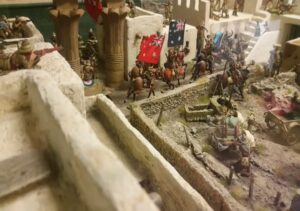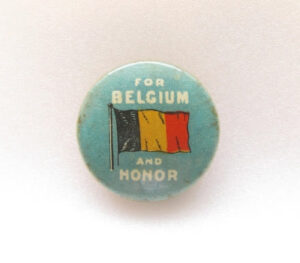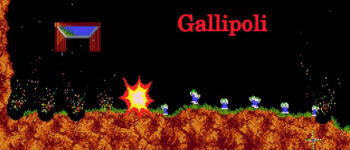1915: Fiasco at Gallipoli
April 25, 2024
By AHNZ
 Today in history, 25 April, 1915, we invaded Turkey from the Gallipoli Peninsula. It was a gamble, a fiasco, a disaster, and the object of a national propaganda exercise so complete that it re-framed our national identity. Colonial New Zealand had been a much freer place to live, almost Libertarian. The Millennial Age that followed it, that lasted well into the 2020s, saw the rise of an all-powerful State and concomitant reduction in our rights and liberties.
Today in history, 25 April, 1915, we invaded Turkey from the Gallipoli Peninsula. It was a gamble, a fiasco, a disaster, and the object of a national propaganda exercise so complete that it re-framed our national identity. Colonial New Zealand had been a much freer place to live, almost Libertarian. The Millennial Age that followed it, that lasted well into the 2020s, saw the rise of an all-powerful State and concomitant reduction in our rights and liberties.
Take one look at the debating chamber of the House of Representatives with its intricate wood panel interior of carved motifs memorialising The Great War and the message is very clear. It is also no accident that Gallipoli and the war to come launched hundreds of memorial monuments, gateways, and halls. Many of them are in towns that don’t exist anymore as a result of giving up their men for a war that led to their town being obsolete in the new order of things. Every year on ANZAC Day a somber mourning morning has initiated a public holiday reminiscent of ancient Egyptian death-worship faith. Egypt, of course, is also where our Gallipoli invasion started from.
The “glorious dead” ANZAC soldiers’ “Supreme Sacrifice” must not be doubted or questioned. Tons of concrete has been poured, hundreds of thousands of pages written, thousands of hectares redistributed, poppies sold, brass polished, salute guns fired, and bugles blasted to make sure. Scores of artillery war loot has been imported and mounted outside of RSA restaurants paid for by the same society ladies charities who had shamed our men to go to the war in the first place. Generations of speeches, local street parades, wreath-laying, books, documentaries, Turkish holidays, and special museum exhibits promise “We will remember them.”
Of course we don’t remember them at all, that’s all humbug and platitudes. The facts and memory must not be discussed because they get in the way of a national myth held together with dawn services, poppies, concrete and steel monuments, and funerary processes. In fact, all that superstructure of martyrs and shrines exists and was invented specifically to suppress and repress the memory of what Gallipoli and the Great Wrong War really was.
“After being postponed by bad weather, the landings took place on April 25. The plan went out the window almost immediately. A navigational error meant the Anzacs landed almost 2 kilometres north of the intended landing site, at a compact bay now known as Anzac Cove. Instead of the open beach they had expected, the terrain was steep and rugged. Confused and disoriented, the men found themselves under increasing pressure from the defenders as they struggled up the ridge. By the end of the day, there were so many casualties an evacuation was recommended.” – Gallipoli: A series of failures Siobhan Downes, Stuff (2015)
“In the early months of the war, the reassuring refrain that ‘the boys will be home by Christmas’ was all the encouragement that the country needed to send over a hundred thousand troops to fight in the other hemisphere. But the havoc at Gallipoli caused a sudden, jolting loss of this naivety, and as New Zealand soldiers began to die in a far more protracted and intractable conflict, the country sank into a deep trauma.” – Encounters- The Creation of New Zealand, Paul Moon (2013)
“When questioned, they speak of the high ideals and noble causes for which those who were killed and maimed in the Great War sacrificed themselves. They do not know, because they have not been told, that the Anzacs died for an imperial economy which, even in 1915, had ceased to be internationally competitive. They do not know, because they have not been told, that Britain’s decision to go to war with Germany was not taken in defence of ‘poor little Belgium’, but in the hope that, between them, France and Russia would destroy the British Empire’s principal economic rival. They do not know, because they have not been told, that the Anzacs slaughtered tens of thousands of young Turks so that the British and their French allies could carve up the territories of the Ottoman Empire…Massey’s government did not dispatch 19.4 percent of its male population to the killing fields of Gallipoli and Flanders to ‘make the world safe for democracy’, but to keep safe, and if possible expand, New Zealand’s ‘protein industry’.” – No Left Turn, Chris Trotter (2010)
“War! There is no conception more inspiring, no condition nobler, no call that rings more grandly in the ears.”- NZ Herald, 8 August, 1914
“For 6 months they jostled and maneuvered with recounts and buy-elections and challenges. Meanwhile, the pot they had set on the stove was boiling over. Gallipoli and the sobering casualty lists came during this time while nobody had a hand on the political wheel.” – 1914: Hung Parliament, AHNZ
“Guaranteed orders from Britain for New Zealand’s primary products at generous prices meant the war was almost embarrassingly profitable.” – We Won, You Lost. Eat That!, Paul Goldsmith (2007)

‘They gave there lives that others may live,’ apparently. On the other hand, 131,000 (87,000 Ottoman and 44,000 Allied soldiers) gave their lives for a stalemate.
Just as Richard Seddon’s Government leveraged the lives of young men for a trade deal, Massey and Ward’s National Government handed over our men in exchange for special trading status for our “protein industry.” A generation was slaughtered but the quid pro quo was near “embarrassingly profitable” for the domestic economy (by design.) Ref. Trotter (2010) and Ref. Goldsmith (2008)
The farm boy Kiwi youngsters who ended up being exploited at Gallipoli and for 100 years after as deificatio postmortus never volunteered for their fate at all. They thought they were going to Salisbury Plain, England, for training and then off to see Europe before the whole shebang was ‘over by Christmas’. In an era where even high school was user-pays it was the shot of a lifetime for an all expenses paid adventure to see the Mother Country.
It was these reckless young cannon fodder, dupes of The State, who were alchemically changed into “glorious dead” who “gave their lives” to serve the national myth. The fiction we have of these men isn’t making their memory sacred at all but distorting and desecrating it. Massey and Ward certainly had no choice but to re-frame it that way or they would have been pilloried for what they had done.
Arriving instead in Egypt the youths continued to be anything but the cartoon characters they would become in minor keys and bugle dirges. Finding training dull and boring, they re-invented larrikinism and became the hooligans and pranksters of Cairo. They still were not ‘adulting’ and paying attention to what they’d gotten themselves into. Likewise, back in New Zealand the ruling class bickered back and forth with re-counts and buy elections for 6 months straight unable to form a Ministry. Ref. 1914: Hung Parliament, AHNZ
Now came the Dardanelles Campaign to invade from Gallipoli’s open beach. Winston Churchill’s plan, a pretty bold and worthy one but it was poorly done by incompetent, changing, and indifferent British generals. Into the ready and waiting hands of Mustafa Kemal/Ataturk we did go after announcing it with weeks of bombardment. Not, however, onto the open beach but by accident we wrongly tried to invade in the dark the sheer cliffs. Maps were useless, preparation and careful plans wasted, 2000 of ours were dead for nothing on Day 1.
 We never got to realise the imagined image in the picture above of riding into Turkey to become its masters. The propaganda that got us into this mess kept coming and has never really abated. By 1916 the lies had become obvious to recognise. At least, it was for our men at Galllipoli but the people at home would catch on after a propaganda-created lag. The Battle of Chunuk Bair, concluded 10 August, 1915, delivered the verdict: New Zealand’s ANZACs were cannon fodder in a no-win situation. We had been misled. The Evacuation of Gallipoli was the only part of the whole affair that was done well.
We never got to realise the imagined image in the picture above of riding into Turkey to become its masters. The propaganda that got us into this mess kept coming and has never really abated. By 1916 the lies had become obvious to recognise. At least, it was for our men at Galllipoli but the people at home would catch on after a propaganda-created lag. The Battle of Chunuk Bair, concluded 10 August, 1915, delivered the verdict: New Zealand’s ANZACs were cannon fodder in a no-win situation. We had been misled. The Evacuation of Gallipoli was the only part of the whole affair that was done well.
The Expeditionary Generation would eventually locate their brains and their adulthood but only after great cost. Our war veterans are famous for not wanting to talk about their experience or their thoughts and feelings; They have suppressed it as has the entire nation. We’re ashamed of how silly we were for getting into the Great Wrong War and for Gallipoli in particular but that shame is so deep we bury it with myths and monuments. Myths like “they sacrificed for our freedom” or for the liberty of Belgium. We even sustained this myth by re-naming biscuits after Belgium and the ANZACs!
Gallipoli was a fiasco at the leading edge of a bout of mass hysteria that gripped New Zealand light a nightmare. It set the consensus for an age (aka Saeculum) and really did define our national identity and distance us from the old Colonial Identity we cast out. It has been an age of high taxation, expanding government, centralised control, bureaucratic governance, dumbing down, mass media, identity crisis, and paternalism. You’ll know it’s over because RSAs will close, war monuments quietly vanish, biscuits be re-named, ANZAC services fall into abeyance, and the House debating chamber re-decorated¹. It has been a national identity based on willful amnesia, differential enforcement of laws and rights, deference to American decadency, security dependency, ego insecurity, unacknowledged corruption, victimhood addiction, the Tall Poppy Syndrom, expert-worshipping, corporitising, that is debt-based with a massive inferiority complex. All badly handled grief and trauma from the Great War. New Zealand is an old schizophrenic man.
It would be really great when next we build New Zealand to do a better job of it.
—
1 Probably due to accidentally catching fire. Like last time, 1907.
Image ref. Malcolm Evans observes in cartoon form ‘Anzac day and the new generation’, New Zealand Herald (2001); Alexander Turnbull Library
Image ref. Scale model imagining of a successful breakthrough of the ANZACs at Gallipoli, NZ Museum of Toys & Collectibles, AHNZ Archives (2021)
3 thoughts on "1915: Fiasco at Gallipoli"
Leave a Reply
 Like Comment Share
Like Comment Share






This was a great read. Our history is a moving target, and at the moment it is moving just as fast as it was back then.
Thanks. I think you’re right and hope I can figure it out what’s going on before it becomes obvious.
Well done for calling out this hypocrisy.
Was Belgium rightfully placed to declare war on Germany, who only wanted a road through?
I think of this war and all the propaganda, as you have mentioned, as part 1 and part 2 of the same battle, a desire to strip prosperous Germany of their well manufactured implements, not once, but twice.
It was easier to believe in round 2, we already knew the Germans were the baddies, pitchforking babies, raping nuns, tipping babies out of incubators…
What did the globalist bankers get out of part 1? Balfour gifting Palestine as a homeland, “after all who could deny it after everything they went through”, never mind this was part 1 of a 2 part combo. The Chicken laid the egg in 1910, didn’t hatch until 1947.
Sigh, it’s all propaganda which has stuck in the public craw. Who was really pulling the strings? Some folks say this jew world order/ globalists was founded away back then.
I dare anybody to take on part 3, the follow up propaganda war, the “what they did to us”, do a fact finder, clear the mis-disinformation.
Follow the narrative to the round about where we are today, the genocide, the propaganda them vs us, the globalist nature of this venture.
They lean heavily on ancient scripture, when Israel was a tribe, a province, and they tend to forget about the removal of favoured people status.
They assume the mandate of God. It is known, the temple rituals ceased at the moment of jesus’ crucifiction. Their was a ritual where a door opened, a crimson cloth turned white, a candle would spontaeously light. Sacrifices were in vain.
Extrapolate this to today, they are rebuilding the template, fattening the perfect red heifer, all in the name of a religion which is dead.
Biblical prophecy, Gog and Magog, invaders from the north, could’ve been the Khazarians which flocked to the newly established state?
Presently waiting on the battle on the fields of Geddon.
Read revelations, look for an intrpretation of the beast systems, the horns coming up, a little horn arose, but was destroyed by 4 bigger horns.
Sigh, enough for a Saturday morning..